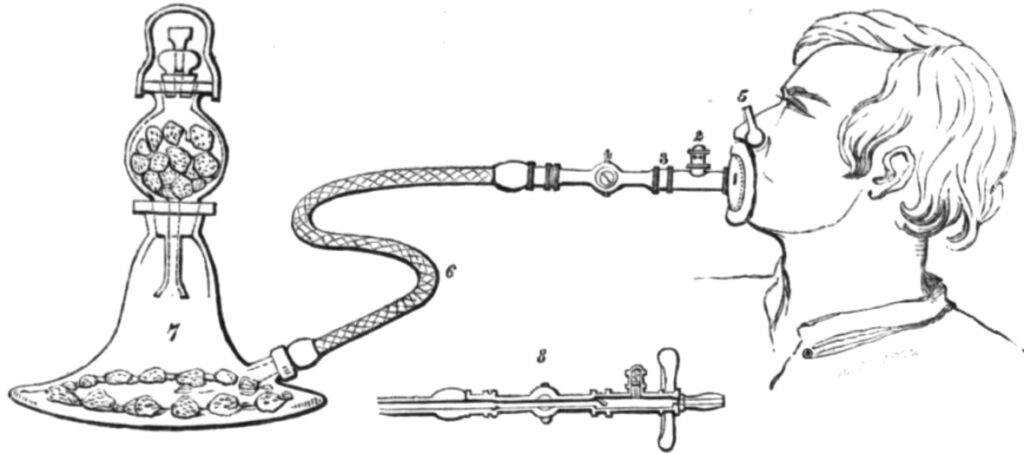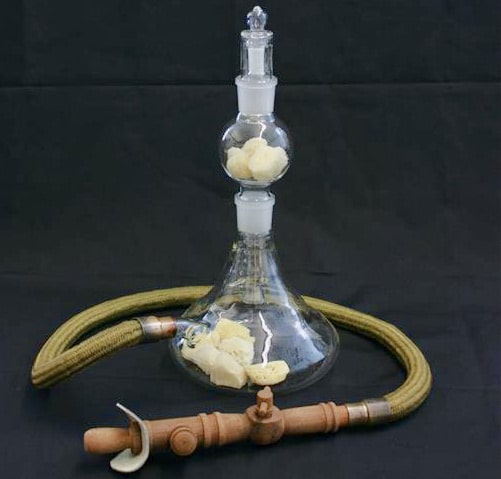William R. Pugh
William Russ Pugh (1806-1897) was an English anaesthetist and surgeon
Pugh spent much of his career working in Australia where he established his own private medical practice St John’s Hospital in Launceston. He is well known in anaesthesia providing the the earliest documented use of sulphuric (di-ethyl) ether for surgical anaesthesia in Australia, on June 7, 1847. Pugh administered the ether (which he manufactured himself) by means of his own apparatus ‘Pugh’s Inhaler.’ This was devised in his own house in an attempt to recreate an apparatus he’d seen in a diagram in a newspaper.
Pugh possessed a creative mind and was a prideful and stubborn practitioner. On one side his stubbornness was his greatest strength and saw him pursue multiple experiments for the sake of medical research culminating in the development of his respirator. On the other hand, his stubbornness was also his greatest flaw and saw himself estranged from medical colleagues and pursued at one stage by 17 law suits. Either way, Pugh’s skills and knowledge made him a valuable asset to anaesthetic practice in Australia and despite returning later to the UK, his legacy remains unforgotten and is commemorated today by a statue outside his former home in Launceston.
Biography
- Born on October 25, 1806 in Southwark, London
- Completes medical education in the UK and becomes a graduate of the Faculty of Physicians and Surgeons of Glasgow and of the Royal Colleges of Edinburgh
- 1835 – travels to New Holland (now Australia) arriving first in Van Diemen’s Land (renamed Tasmania in 1855); walked from Hobart to Launceston (200km)
- 1841 – appointed sub-agent for immigration and health officer for the port of Launceston
- 1843 – founding member of the Royal society of Tasmania; his interest in geology, zoology, mineralogy and meteorology sees him conduct multiple presentations to the society
- 1844 – MD from Giessen University; establishes a medical practice – St John’s Hospital and Self Supporting Dispensary – in Launceston and is nominated to the court of medical examiners where he provides his expertise in cases of poisoning; works with his partner Dr James Grant with whom together they engage in experimental practice in the name of research – a prime example is the prescribing of drugs, most of which are prepared from plants grown from his house. Indeed his creative sprit sees him produce his own ether and coal gas to light his house.
- 1847 – Pugh’s experiments lead him to become the first practitioner in Australia to successfully use ether for operations; his reputation as a surgeon begins to grow and he appears in the local press; the instrument he uses to deliver the ether – ‘Pugh’s Inhaler’ – is constructed in his own home copying an apparatus he had seen in the Illustrated London News. He publishes his cases and experience in the Australian Medical Journal
As it may be of interest to your readers to receive local testimony, in addition to the published reports of cases, in which surgical operations have been divested of the usual suffering attendant on such proceedings by the use of Etherial inhalation, I beg to furnish you with the results of a trial of this novel discovery, made at St. John’s Hospital to day
Pugh WR, 1847
- 1854 – due to financial difficulties, Pugh is forced to close St John’s Hospital and moves to Melbourne
- 1872 – returns to England permanently
- Dies on December 27, 1897 in London, aged 91; A monument is dedicated to his memory in Launceston opposite his former home
Medical Eponyms
Pugh’s Inhaler
Inspiration for Pugh’s Inhaler came from a drawing in Illustrated London News (January 9, 1847) – at the time, the paper detailed an account of the device introduction by dentist Dr William Morton, and first operative use in England by surgeon-dentist Mr Robinson on December 18, 1846.

The apparatus employed consists of the lower part of Nooth’s apparatus, with a flexible tube, to which are attached a ball and socket valve and mouthpiece, similar to those used for inhalation. Illustrated London News 1847
Pugh modified a Nooth’s apparatus, to create his own inhaler: a device that similarly allowed him to deliver surgical anaesthesia in Australia for the first time.
The apparatus comprised an inverted funnel shaped glass jar connected to a top glass globe via a valve. Within the glass vessels were pieces of sea sponge which were saturated with ether. A flexible tube with a stop cock and mouthpiece were attached to the lower glass vessel and provided the means to deliver ether to the patient.
Pugh’s inhaler allows him to perform two successful operations at St John’s Hospital – the removal of a tumor from a girls jaw and removal of cataracts from a man. To document the event he had invited Mr James Aikenhead, the founder and first editor of the Launceston Examiner. To assist him he had invited a colleague, Dr Benson, to help. Between them they asked the first patient to place the breathing tube in her mouth and inhale, while Dr Benson pinched her nose before applying a nose clip so he could hold her head. In this manner Dr Pugh removed two teeth and a tumour from her jaw.

Major Publications
- Pugh WR. A letter to the medical profession of Van Diemen’s Land : accompanied by the particulars of an operation for strangulated congenital hernia 1845
- Pugh WR. Operation for strangulated scrotal hernia. Australian Medical Journal 1846; 1(5): 51-52
- Pugh WR. Gun-shot Wound and Amputation at the Shoulder-joint. Australian Medical Journal 1847; 1(7): 75-76
- Pugh WR. Amputation of the forearm. Australian Medical Journal 1847; 1(9): 100-101
- Pugh WR. Original cases and communications. Australian Medical Journal 1847; 1(12): 141-142
- Pugh WR. Compound fracture of the leg – amputation. Australian Medical Journal 1847; 2(1): 7-8
Controversies
Pugh was a very passionate and proud man with a penchant for experiment in his practice. This inevitably provoked hostility among his fellow medical colleagues and at one stage had 17 law suits out against him – most famously, Pugh was said to have prosecuted a medical practitioner who had doubted Pugh’s ability; unable to pay the fine for the malicious persecution, his fellow practitioner was gaoled for 12mths!
Another incident involved the Banker Lewis Giles whom Pugh’s was acquainted with through his membership in the Launceston Club. A missing letter sparked the controversy – Giles had invited Pugh and his wife to attend a ball, a letter which never found its recipient and saw Pugh and his wife neither respond nor attend the function. This drew the ire of Giles and what followed was a war of letters which escalated to Pugh publicly insulting Giles.
SIR. – Having learned that Mrs. Pugh is supposed to have been guilty of a breach of civility in not replying to a note addressed to her by Mrs. Gilles, I beg to state that Mrs. Pugh is in ignorance of having thus been addressed by Mrs. Gilles, and that no member of my establishment is aware of the delivery of such a note. – I am, your’s &c.
W.R. Pugh, June 1842
I charge Mr. W. R. Pugh, as a member of this club, with conduct unbecoming a gentleman, and derogatory to his station in society; he, the said W. R. Pugh, having made an assertion which was contrary to the fact, and when found to be unfounded, that he, (Mr. Pugh) had neither the candour to admit his error, or the spirit to justify his behaviour
Lewis W. Gilles. Launceston, July 5, 1842
Mr. Lewis William Gilles having instituted charges against me derogatory to my character, which he has failed to substantiate, and having refused to afford me satisfaction, I hereby proclaim him a COWARD and a LIAR
W.R. Pugh, July 8, 1842
On Thursday, 6 October 1842, The Chief Justice, Sir John Pedder, presided over a hearing in the Supreme Court in Launceston, with a jury of 12 men, in which defamation and libel were alleged. After a few minutes consultation, the jury returned into court with a “verdict for the plaintiff – damages, ONE FARTHING”. – rather than the claimed damages of £2000
The causalities? Financial ruin for Giles, a hit to the reputation of Pugh and dissolution of the Launceston Club. The missing letter was later found by the maid to be tucked between the pages of a book on the dresser.
References
Biography
- Pinkerton HH. Dr William Russ Pugh. BJA. 1967;39(10):834
- Paull JD. The perils of pointing the finger: a lesson for Dr. Haygarth. Anaesth Intensive Care. 2007 Jun;35 Suppl 1:32-6
- Paull JD. Gilles vs Pugh and the lost letter. Anaesth Intensive Care. 2009 Jul;37 Suppl 1:42-6
- Paull JD. William Russ Pugh’s remarkable life: natural scientist, innovative anaesthetist and founding member of the Royal Society of Tasmania. Anaesth Intensive Care. 2011 Jul;39 Suppl 1:18-26
- Paull JD, Morris GM. Dr Pugh: a poisoner? Anaesth Intensive Care. 2012 Jul;40 Suppl 1:18-21
- Paull JD. Not just an anaesthetist: the remarkable life of Dr William Russ Pugh MD. 2013
- Paull JD. Dr Pugh and the myth of the illicit still. Anaesth Intensive Care. 2014 Jul;42 Suppl:41-4
- Paull JD. Discovery of the journal written by Dr William Russ Pugh on his voyage from England to Van Diemen’s Land in 1835. Anaesth Intensive Care. 2016 Jul;44 Suppl:45
- Haridas RP, Paull JD. St John’s Hospital (Morton House), Launceston, Australia: A history of the hospital and Dr William Russ Pugh’s first operations under ether. Anaesth Intensive Care. 2017 Mar;45(7):29-36
- McDonald T. Doctor William Pugh’s Australia-first ether. The Examiner. 2017
- Huth J. William Russ Pugh. Monument Australia.
- Craig CVJ. Pugh, William Russ (1805–1897), Australian Dictionary of Biography, 1967 Vol II
- Bibliography. Pugh, William Russ 1805-1897. WorldCat Identities
Eponymous terms
- The new means for rendering surgical operations painless. Illustrated London News, January 9th 1847
- Cussen P. On the inhalation of the vapour of aether. Australian Medical Journal 1847; 2(3): 32-33
- Pugh’s inhaler (replica). Geoffrey Kaye Museum of Anaesthetic History
- Crowther WE. The introduction of surgical anaesthesia in Van Diemen’s Land. Med J Aust. 1947 Nov 8;2(19):561-70
[cite]
Emergency registrar at Sir Charles Gairdner Hospital, Perth


